Japan June travel seasonal highlights, themes and attractions
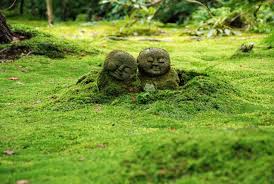
The Japan June travel season is the season of rain, mostly on Honshu Island but also in other areas. Known as tsuyu in Japanese, the rainy season can be fantastic, but it can also be very wet. And yet for all the inconvenience of rain, there are many pleasures as well.
Weather reports in Japan during June rainy season are quite accurate and it certainly doesn’t pour every day. In fact, it rains about 10 days in the month of June and on many days the rain falls around the same time, so it is easy to prepare in advance.
But do bring gum shoes, rain paints and either a poncho or a water-repellent jacket (preferably breathable material as June in Japan is hot and humid).
You can tell if it’s going to rain by the number of people you see walking outdoors with an umbrella in their hand. In the old days, the Japanese used very wide and wonderfully colorful wax paper bamboo umbrellas. Or if you were rich enough, you were carried through the rain in the snug and dry comfort of an enclosed palanquin. Today, of course there is the train, subway and short taxi rides to get to your final destination.
From the perspective of a Japanese farmer, the June rainy season is a blessing from the gods. Nothing loves water as much as rice, which as everyone knows is the backbone of daily living throughout Asia. June is traditionally the month when rice is planted in on the Japanese islands. If you are lucky this month you will see young and old women and men alike stooped over ankle-deep in the fields, patiently sticking rice seedlings through the water into the rich bed of muck below. Of course, many farmers use machines for this today. But all the same it’s not unusual to see hand planting in smaller fields at the edges of Kyoto, Tokyo and Osaka.
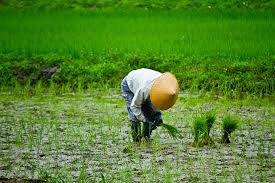
In June, when it is raining outside and you are in a traditional Japanese house or temple, you will often find yourself drawn to the engawa walkways that boarders the garden. This is perfect spot to place a cushion and nurse a hot drink while watching the rain. Set about 40 centimeters off the ground, the en is unique to Japan. It is made of simple slats of wood, sometimes with slight spaces between them, and is generally one of the cooler places in a traditional Japanese house. And the serene experience of watching a garden alive in the rain is special.
Whether it’s raining or not, June is the greatest month of the year for frogs, who of course also love planted rice fields. And if you are in Kyoto or elsewhere in Japan this month, take the time to walk after sunset in some of the residential areas where rice fields are still plentiful listen to the endless and often unbelievably loud choruses of frog song.
On evenings when it’s not raining, especially right after it has rained, you might be lucky to experience the wonder of hotaru (fireflies) glowing erratically and mysteriously through the darkness along a clear stream. Not so long ago, to go out in the evening and try to catch one was a much-anticipated excursion for children. If you catch one, you have the mystery in your hand, though you will be no closer to understanding this odd natural wonder. Some good places to go and see hotaru fireflies in Kyoto are as follows: 1) along the stream running down the length of Tetsugaku-no-michi (The Path of Philosophy). 2) Along the stream running beside the road from Kibune-guchi Station to the start of Kibune village. 3) Along the canal running east-west from Shimogamo Hondori, just north of Kitaoji Street.
In the Japanese tea ceremony, the month of June has been poetically captured with “goma” associations that capture the essence of each 10-day period: early June, mid-June, late June. These key words and themes that have been classically repeated in Japan for more than 1,200 years. The June goma key words can help you “imagine” what to expect when you travel in Japan in that month. Early June themes: Ajisai hydrangea flowering bushes. Hotaru fireflies. Cormorant fishing. Mid-June themes: Sound of a stream flowing by. Ashi reeds (generally used to make thatched roofs). Aoi ume green plum fruit. Late June themes: Taue rice planting. Nagoshi summer purification rituals and rites. Circular, standing chinowa grass portals through which people pass during summer purification rites at many Shinto shrines (but especially Kyoto!).
As the heat rises in June, and the humidity too, images of “coolness” can be seen everywhere: white herons, water, rain, fans, green bamboo, unlacquered wood, waterfalls, the seashore, blue or silver. Unglazed ceramics such as Bizen or Shigaraki ware also impart a feeling of coolness.
- Japan June travel food highlights
- Japan June travel tree and flower highlights
- Japan June travel festival highlights
- June ume pickled umeboshi plums for bentos and health
- June is the month of vinegar as summer begins
- June Interview: Hinaya natural dye studio in Kyoto
Content by Ian Martin Ropke, owner of Your Japan Private Tours (est. 1990). I have been planning, designing, and making custom Japan private tours on all five Japanese islands since the early 1990s. I work closely with Japan private tour clients and have worked for all kinds of families, companies, and individuals since 1990. Clients find me mostly via organic search, and I advertise my custom Japan private tours & travel services on www.japan-guide.com, which has the best all-Japan English content & maps in Japan! If you are going to Japan and you understand the advantages of private travel, consider my services for your next trip. And thank you for reading my content. I, Ian Martin Ropke (unique on Google Search), am also a serious nonfiction and fiction writer, a startup founder (NexussPlus.com), and a spiritual wood sculptor. Learn more!
Japan June travel food highlights
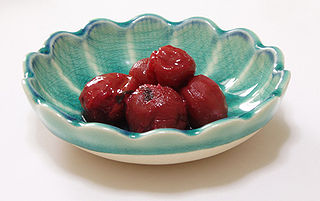
Ume plums: June is the month when the ume plums are harvested and turned into a powerful digestive or an equally appreciated "sherry-like" alcohol. Both are activities still carried out in traitional homes but you can also find an amazing range of umeboshi pickled plums and umeshu plum wine in all supermarkets, convenience stores and more than a few specialty shops all over the country. The plum plays a fairly important role in the Japanese diet. Umeboshi, or pickled plums, are a mainstay feature of most Japanese meals. Being highly alkaline in nature, they serve to neutralize the stomach and aid in digestion. Umeboshi are usually dyed red with food coloring. When placed into the center of a lunchbox of white rice, the result is called the hinomaru or the Japanese flag. However, for many, the greatest pleasure derived from the plum is derived from the fine liqueur known as umeshu. This month, people all over Japan will be buying fresh ume plums to make umeboshi and umeshu. For more about umeboshi see the section below or click on it in the index.
Minazuki cakes: Another food or better said treat that is associated with June are the white, triangular gelatinous sweets called minazuki. These cakes are especially eaten on June 30th as way to prevent sickness in the remainder of the year. In ancient times, plague and sickness often occurred in the hot summer months. Made from gelatinous layer of wheat flour that comes in three colors (white, plain; brown, sugar-flavored; green, tea-flavored) these sweets are covered in a layer of red adzuki beans. If this food doesn’t interest you, then you might consider kuzumochi or arrowroot cakes, small white triangles eaten with a brown syrup and kinako soybean flour.
Japanese vinegar: Su or Japanese vinegar adds a subtle taste to many classic Japanese food dishes and June is traditionally associated with vinegar (see section below for details).
Japan June seafood picks: Ayu river trout: This month consider ayu. Small and trout-like, ayu is characterized by a light taste, generally complimented with a spicy vinegar-based sauce, known as tade-su. Ayu are usually small (up to about 16 cm). The small ones don't have to be deboned, and you can eat the insides as well. Sea bass: Another summer treat is Japanese sea bass, a delicately flavored fish prized for its white meat and the fact that you can prepare it in so many ways. Katsuo bonito tuna: Katsuo (bonito; related to the tuna) is also a recommended summer treat. Traditionally, the fillets are seared in a short-lived but extremely hot rice-straw fire. At the finest establishments, katsuo tataki is grilled and smoked over green cedar branches, followed by a quenching quick plunge into ice water to seal in the flavor. After that it is sliced and placed on wakame (seaweed), garnished with ginger, etc. and a lemony sauce, and then allowed to marinate for a bit in a cool place.
Japan June travel tree and flower highlights
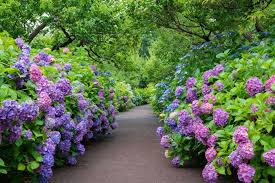
Lotus: In mid-June the lotus (hasu) flowers begin to spring forth from muddy pond waters openeing into large thick pink or white flowers. The flowers open at dawn and close by mid-afternoon. Its short-lived blossom suggests reincarnation; the wheel-like leaves and spike-shaped petals imply the perpetual cycle of existence; and the pure flowers rising from the mud symbolize enlightenment for anyone.
Ajisai (Hydrangea): Hydrangea have a fairly long season beginning in June and can be seen at many historical locations all over Japan. Kyoto’s Sanzen-in Temple has over 3,000 hydrangea bushes of various kinds, and their various shades of blue and lavender wonderfully liven up a rainy June day.
Sal Tree Viewing: Sal tree viewing is best in Kyoto because the tree is almost always in a Zen setting of which the city has many. But you can also experience sal trees in Kamakura just west of Tokyo, another Zen center.
Japan June travel festival highlights
Yosakoi Soran Festival (early June, Sapporo): The Yosakoi Soran Festival is a Yosakoi dance festival featuring 300 teams and 30,000 dancers. Most of the teams are university and college teams that come from all over Japan to compete. Sapporo is on the northern island of Hokkaido and has no rainy season. Sanno Festival (June 7-17, Tokyo): The Sanno Festival involves a long parade of 25 kilometers through the streets of central Tokyo. It also includes several smaller events at Hie Shrine. Hokkaido Shrine Festival (June 14-16, Sapporo): A standard Japanese festival with mikoshi, a float parade and festival food. It has a local feel with few international visitors. Northern cities have a special enthusiasm for Spring and the locals jump at a chance to put on yukata and spend time outside in June. The festival attracts 1 million people, representing about half the population of the city.
- Japan June travel food highlights
- Japan June travel tree and flower highlights
- Japan June travel festival highlights
- June ume pickled umeboshi plums for bentos and health
- June is the month of vinegar as summer begins
- June Interview: Hinaya natural dye studio in Kyoto
June ume pickled umeboshi plums for bentos and health
A highly poetic name for the rainy season is bai-u or literally, 'plum rain', for when the rains come, the plum trees (ume) bear their fruit. June is the month when ume or plums are harvested. The plum plays a fairly important role in the Japanese diet.
Sour and salty, umeboshi turn up at almost every Japanese-style breakfast and in many a boxed lunch, or bento. Being highly alkaline in nature, they serve to neutralize the stomach and aid in digestion. Umeboshi are nowadays often dyed red with food coloring. When placed into the center of a lunchbox of white rice, the result is called the hinomaru or the Japanese flag.
Indeed, life without umeboshi would be unthinkable to the Japanese, who often take them along on trips abroad, like so many little red talismans. Many even swear that an umeboshi a day keeps the doctor away. But let a foreigner claim to actually like these mouth-puckering pickles, and the reaction is one of stunned disbelief!
The traditional pickling process is simple but long: in June the unripe fruit is picked and allowed to soak in salt water. Then they are packed with red shiso leaves which color the plums while imparting a better flavor. They are then left to age in large jars for several months. After that, the plums and shiso leaves are taken out, put in the hot summer sun, and left to dry. Finally, they are re-packed in smaller containers for home storage.
However, for many, the greatest pleasure derived from the plum is from the fine liqueur known as umeshu. This month, people all over Kyoto will be buying plums to make umeshu. Umeshu is also made using the unripe fruit. Each plum is carefully wiped with salt water and put in a large glass jar. Sugar and rice liquor (not sake, but the stronger distilled shochu) are added, and the jar is stored in a dark, cool place. Although ready to drink in about three months, it tastes better if aged at least a year. The most popular fruit wine in Japan, umeshu is also highly regarded for its medicinal properties and is considered good for stomach disorders.
But no need to worry you don’t have to wait until next year to enjoy it. Umeshu is ready fairly quickly. Of course, there’s usually lots left over from last year. It is often served as a starter before a meal.
If you're feeling wilted on a hot and humid day, try a Japanese pick-me-up: an umeboshi with a cup of green tea, or some umeshu on the rocks. Either one is sure to do the trick!
June is the month of vinegar as summer begins
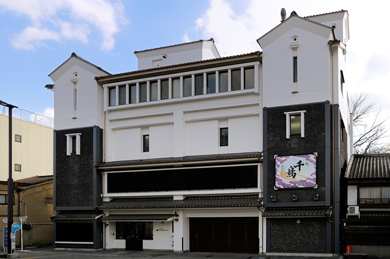
Large scale Japanese vinegar production dates back to the Muromachi period (1333-1576). Before that time, vinegar, like sake, was a luxury product available only to the aristocracy. Beginning in the Genroku era (1688-1704) vinegar came into wide use to fix the color in dyed kimono fabric. This process is no longer carried out with vinegar and so today the only vinegar makers surviving in Kyoto are the ones making vinegar for cooking.
Murayama Zosu produces its vinegar through a series of separate stages. First, they take normal white rice and saccharify it. Following this they ferment the mixture into alcohol. Finally, they add an acetic acid producing bacteria and allow the mixture to ferment further until it becomes vinegar. Murayama Zosu produces its vinegars using two methods: 1) their handmade vinegar making process takes about three months from start to finish. 2) using machine production techniques, the company produces about 1,000,000 liters of vinegar a year.
It is almost impossible to talk about authentic Japanese cuisine without vinegar. For example, how could we enjoy the special taste experience of sushi without vinegar? Kyoto vinegars are made to complement the subtle blend of flavors that traditional Kyoto cuisine is known for. In particular, no one flavor should dominate the overall taste, so Kyoto vinegar is very light in comparison to vinegars made in other parts of the country.
Most of Murayama Zosu's production is sold directly to restaurants and retailed through supermarkets and in the Kyoto food specialty corners of major departments stores. Some of their best products are sold directly to Japanese restaurants in London and Paris, mainly because the vinegar in Europe is much too strong for Japanese cooking purposes.
For visitors interested in visiting Murayama Zosu's factory, tours can be arranged (advanced reservations are required, and an interpreter should accompany visitors not fluent in Japanese). For more information on arranging a tour or buying some of their products (their mustard-like vinegar miso is highly recommended) telephone the company on 761-3151. Their traditionally styled newly rebuilt factory/office is centrally located on the south side of Sanjo just west of Higashioji.
- Japan June travel food highlights
- Japan June travel tree and flower highlights
- Japan June travel festival highlights
- June ume pickled umeboshi plums for bentos and health
- June is the month of vinegar as summer begins
- June Interview: Hinaya natural dye studio in Kyoto
June Interview: Hinaya natural dye studio in Kyoto
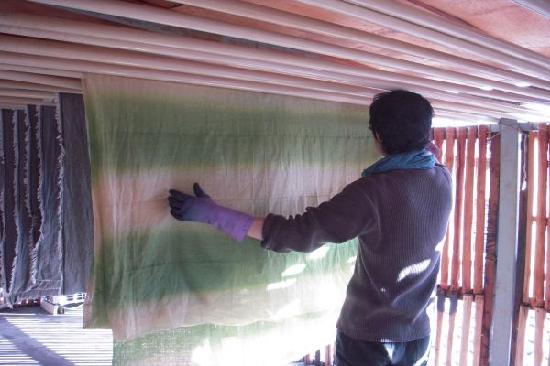
A talk with Masayo Motojima of the Hinaya dye studio in Kyoto. This studio colors silk fabrics using materials from trees, plants and insects.
YJPT: Can you tell me a little about your background?
MM: I was born in Kyoto and lived here until I finished university. Then I moved to Tokyo to work in an advertising agency. A few years after that, I got married and decided to raise my family in Kyoto. Upon my return to Kyoto, I met an old classmate of mine, Izukura Akihiko, a natural dyeing artist. I was very impressed with his work and his passion and decided to work for him at his company, Hinaya.
YJPT: What kind of dyeing are you involved in?
MM: At Hinaya everything is natural dyed, which is the exception in today's chemical driven world. Natural-dyed clothing looks and feels better with time. And once you start to wear this kind of clothing, you begin to become more sensitive about the natural things in life, like food, lifestyle and so on. I am mostly involved with a kimono fabric, called Kusagoromo [grass cloth] that Hinaya developed. Kusagoromo is made of 100% silk, and entirely woven by hand. Usually for kimono, companies use only the best quality silk spun by silkworms. Kusagoromo is special because it makes use of everything the silkworm spins: not just the best. At Hinaya, we try very hard to approach the zero-waste level. This is a big part of our image: the coexistence of nature and human beings. Kusagoromo kimono are much easier to put on. The fabric is very soft, almost like a thick cotton, and hangs easily. We generally design our Kusagoromo kimono with short sleeves. The jacket cut can even be worn with jeans and a T-shirt. Kusagoromo was designed to hold a very thin layer of air. Because of this, the air is able to circulate keeping you warm in winter and cool in summer.
Kusagoromo has attracted people from all over the world. We design Western blouses, scarves and even socks with it. Recently, we have started to use it in furniture, and lampshades. We also sell kits that include the dye stuffs and a wooden weaving loom. We also give dyeing classes in Kyoto. Recently the New York Times interviewed us, and I went to NY to promote Kusagoromo. It was also featured in the English magazine, House & Garden (March 2000).
I’m very happy to see more and more foreign people interested in the natural and traditional side of Japanese life and culture. Many people in the US and Europe are actively interested in our culture. They like gardening, and quite a few of them are passionate about bonsai. A great many Japanese have forgotten these things. The one thing that we have kept and that is rather rare abroad is modesty and humility. I think the Japanese are still very pure in that way.
YJPT: What is so special about natural dyeing?
MM: Mr. Izukura says that every time you dye something with the exact same dye the color is different. It is the same way for human life: every moment is different. Through the art of natural dyeing, we are trying, in a subtle way, to tell people that change is natural, and that change is something to enjoy. Natural dyed products also express the cooperation between human beings and nature. And dyeing is a process imbued with mystery. You can never tell what color will come out. Even if three different people use the same dye stuff, the result will be different. Natural dyeing, like nature, is a miracle.
YJPT: You are a member of the International Association of Natural Textiles. What is that organization?
MM: I started this organization in 1998, and we have many members throughout Japan and some in other countries. Though it is strictly a volunteer activity, I am trying hard to get people together to share their dyeing and textile interests. We hold workshops regularly.
In recent years, many Japanese people have become interested in natural dyeing. Of course, most people are doing it as a hobby. But all the same, they are hiking into the mountains to pick special grasses and dyeing things at home. Hinaya is the only natural dyeing business of its kind in Japan. Unfortunately, this art is a time intensive process, and this makes our products quite expensive.
YJPT: What kind of materials are used for dyeing?
MM: Most natural dye stuffs come from plants. For example, we use onions, chestnut shells, a kind of grass called yashabushi from northern Kyoto prefecture, and another kind of grass called kariyasu, and mugwort. Kariyasu produces a warm yellow, and mugwort a soft green. We also use a few special kinds of insects imported from South America.
YJPT: What steps are involved in the natural dyeing process?
MM: Natural dyeing, as I said, involves an incredible amount of labor and time. Essentially the dyeing process has four basic steps. First the dye plants are boiled at 100 degrees Celsius. Then the plants that will yield the dye and the cloth are cooked at eighty degrees Celsius for a period of 15 minutes. Then the dye is fixed to the cloth using iron or alum. Finally, the cloth is rinsed in water and sun dried. The cooking and fixing processes are generally repeated several times until the desired color is achieved.
Every dyeing process results in a slightly different color, depending on various factors in the fermentation process, how many times the cloth is dipped, and what the weather was like when the dyeing was done. Silk and wool are amongst the most difficult materials to affix natural dyes to. Sometimes, the cloth must be dipped 30 to 40 times.
YJPT: You have lived in Tokyo and Kyoto. What are your feelings about these two very different cities?
MM: Kyoto is much less energetic and, in a way, less creative than Tokyo. I move between Tokyo and Kyoto often, and the first thing I always notice is that Tokyo people walk much faster than we do. In Tokyo, everything is faster. They make decisions faster and they move quickly to get things done. On the other hand, it is very easy to get lost and lose a sense of yourself in Tokyo. That is something that doesn't really happen in Kyoto very often. The rhythms and the environment here are still natural.
I think Kyoto must try to express its culture more to the outside world. At the same time, we have to take in much more information from other cultures. By blending new information with old traditions, we will be able to renew ourselves and continue to grow into the future. If we don't do this, especially young people, Japanese society & culture is going to die out. Kyoto is considered to be a very conservative society. We have to open up more. Opening up doesn't mean that we have to lose our traditional culture. But we do have to reinvent the relevance of what we do. Throughout history, new blood has always played a crucial role. Kyoto needs more new blood, or it will die.
The kimono business is an excellent example of this. Without change, the kimono business could not survive. We must adapt to the needs and tastes of our age. To insist on continuing old skills, traditions and rules from generation to generation doesn't make much sense to me. If we don't create a more vibrant and interesting environment here in Kyoto, young people will continue to leave. As it is, the best of our young people go to Tokyo or abroad. Unfortunately, very few of them stay in Kyoto. We have to change this.
YJPT: Do you have any message for our readers?
MM: I just returned from New York recently, and this time I realized something about Kyoto that I think is important. Kyoto expresses the essence of hannari, which is a blend of softness, elegance and subtle vagueness. Tokyo and many other world capitals are very concrete and direct. There are many things in Kyoto which we cannot express with words. And maybe that is why the arts flourished here for so long, because we expressed ourselves through the things we made and not the things we said. This is something that is extremely attractive about Kyoto. This is a subtle place and I hope foreigners will be able to appreciate the advantages and attractions of being indirect and vague.
Japan month by month private travel & culture summary index
Japan spring travel: Mar, April, May. Learn more!
Japan summer travel: June, July, August. Learn more!
Japan autumn travel: Sept, Oct, Nov. Learn more!
Japan winter travel: Dec, Jan, Feb. Learn more!
Content by Ian Martin Ropke, owner of Your Japan Private Tours (est. 1990). I have been planning, designing, and making custom Japan private tours on all five Japanese islands since the early 1990s. I work closely with Japan private tour clients and have worked for all kinds of families, companies, and individuals since 1990. Clients find me mostly via organic search, and I advertise my custom Japan private tours & travel services on www.japan-guide.com, which has the best all-Japan English content & maps in Japan! If you are going to Japan and you understand the advantages of private travel, consider my services for your next trip. And thank you for reading my content. I, Ian Martin Ropke (unique on Google Search), am also a serious nonfiction and fiction writer, a startup founder (NexussPlus.com), and a spiritual wood sculptor. Learn more!